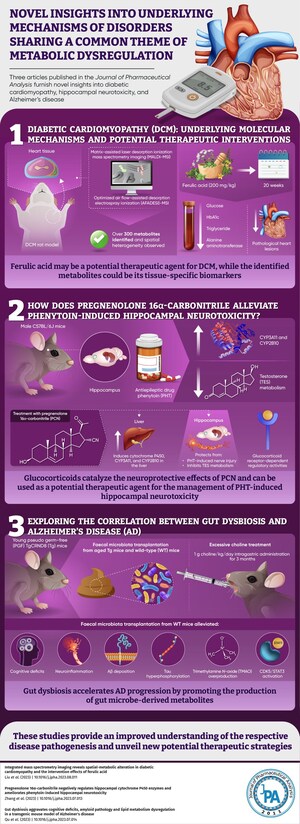Gold Nanoparticle-based Electrode Efficiently Co-detects Dopamine and Uric Acid in Urine Samples, Shows New Study in Journal of Pharmaceutical Analysis
Using gold-containing ternary nanocomposites, researchers develop a novel electroanalytical technique with key diagnostic implications
XI'AN, China, Feb. 23, 2022 /PRNewswire/ -- Urinalysis, or the detection and estimation of various pathophysiological substances in urine samples, is routinely recommended for disease diagnosis. Increased levels of uric acid (UA), for instance, may indicate underlying kidney or heart disease. Similarly, an increase in the urinary levels of dopamine (DA) may indicate the presence of neurological disorders like neuroblastoma or Parkinson's disease. Because pathology labs need to simultaneously determine the urinary levels of multiple substances, techniques that permit such co-detection are necessary. However, such co-analyses sometimes present with technical hurdles. In the case of urine samples, the relatively higher concentrations of ascorbic acid (AA) in urine interferes with the simultaneous detection of DA and UA, both of which are present at relatively lower levels.
A research team led by Associate Professor Dongdong Zhang of Xi'an Jiaotong University, China, has now been able to overcome this limitation through a novel electroanalytical technique that permits the co-detection of DA and UA in urine samples even in the presence of AA.
In their paper, which was made available online on September 17, 2021 and subsequently published in Volume 11 Issue 6 of the Journal of Pharmaceutical Analysis in December 2021, the researchers describe how they combined a nanocomposite mixture, which had an average grain size of 10-9 meters or more, made up of gold nanoparticles (AuNPs), a special (conducting) polymer, and electrochemically-treated graphene oxide over a conventional glassy carbon electrode (GCE), to get a superior electrode. A GCE combines the properties of glass with those of graphite. However, it needed to be modified for the selective and simultaneous detection of DA and UA in the presence of high concentrations of AA.
The researchers employed a combination of chemical and electrochemical methods. They started with poly(3,4-ethylenedioxythiophene), or PEDOT, which is a highly conductive polymer with much promise in the field of biosensors. Explaining the mechanics of their technique, Dr. Zhang says, "PEDOT can be overoxidized to obtain OPEDOT, whose hydrophilicity and unique properties make it useful in electroanalytical applications. However, since OPEDOT is not as good an electrical conductor or catalyst, it is modified with suitable nanomaterials, in this case, gold nanoparticles."
The PEDOT-AuNPs were chemically synthesized from chloroauric acid and 3,4-ethylenedioxythiophene at room temperature. The addition of graphene oxide (GO) resulted in the formation of a homogeneous suspension of PEDOT-AuNPs-GO. This suspension was then dropped onto the surface of a GCE and dried. Finally, following an electrochemical procedure, the nanomaterial OPEDOT-AuNPs-ERGO/GCE was successfully fabricated and readied for bioanalytical measurements.
When used, the modified electrode could simultaneously detect extremely tiny amounts of DA (1 mM) and UA (5 mM) under physiological conditions, even in the presence of a large excess (1.0 mM) of AA. Quite an astounding observation, indeed!
The research team foresees a bright future for this novel nanomaterial-based application, especially in clinical and diagnostic setups. "Our novel, graphene-based, ternary composite, with its advantageous features, is a promising candidate for electroanalytical and clinical applications," said Dr. Zhang.
Future studies are certainly required, but this novel nanocomposite electrode has strong potential to become the gold standard for diagnostics in pathology laboratories.
Reference
Title of original paper: Overoxidized poly(3,4-ethylenedioxythiophene)–gold nanoparticles–graphene-modified electrode for the simultaneous detection of dopamine and uric acid in the presence of ascorbic acid
Journal: Journal of Pharmaceutical Analysis
DOI: https://doi.org/10.1016/j.jpha.2021.09.005
Contact:
Fen Qiu
+86-131-5206-8068
[email protected]
SOURCE Journal of Pharmaceutical Analysis

WANT YOUR COMPANY'S NEWS FEATURED ON PRNEWSWIRE.COM?
Newsrooms &
Influencers
Digital Media
Outlets
Journalists
Opted In






Share this article